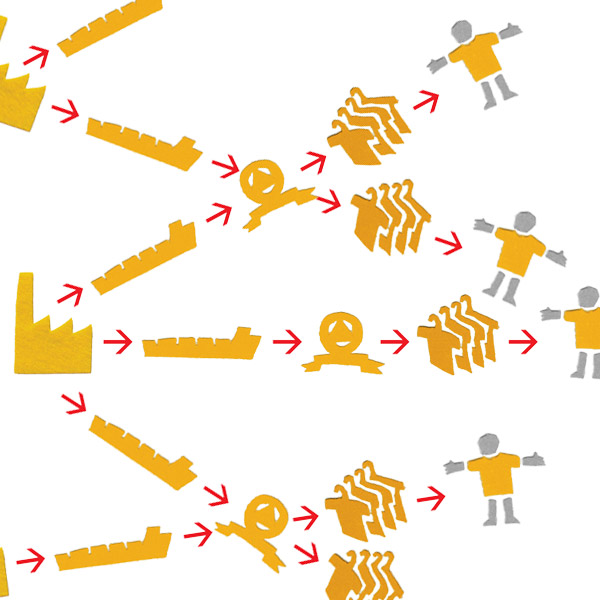TRENDSPOTTING 2016: "The industry has a ‘buyer-driven chain.’ This means that the big retailers and marketers, and traders drive the market (i.e. they determine where to produce, what to produce and at what prices). Hence, retailers and brands, typically situated in developed countries in Europe, Japan and the US. These brands do tasks such as branding, design, marketing and they outsource the production of the garments".

Today the textile and garment industry is a global one and supply -value chains are spread across many countries and continents. Currently the garment industry plays such a role in many least developed and developing countries.Textile and garment industry is one of the key sectors contributing to a country’s overall economy and human resource development. After agriculture, garment industry is the second highest manpower intensive industry. World Garment Market is pegged at almost1.7 trillion USD by 2012. About 60 million to 75 million people are employed in the textile, clothing and footwear sector worldwide (2014 ) whereas to compare in 2000 only 20 million people were employed in the industry and about three quarters of garment workers worldwide are female.

The late 20th century saw a period of significant change in the concentration of the garment market: since that time, the main producing and exporting countries have almost completely changed.In 1970, among the biggest exporters to US were: Japan, United Kingdom, Canada, Italy, France, etc. By 2011, the USA was receiving most imports from countries like China, Cambodia, Pakistan, Mexico, Bangladesh, etc. While even in 1970 countries Production has, in general, shifted to least developed or developing countries. The bulk of production remains in Asia, although the production market in some non-Asian developing countries is growing: e.g. Panama, Chile Egypt. Countries like Turkey, Morocco and Tunisia have emerged as key players when it comes to exports to the European countries.
Developing countries in the buyer driven chain
The industry has a ‘buyer-driven chain.’ This means that the big retailers and marketers, and traders drive the market (i.e. they determine where to produce, what to produce and at what prices). Hence, retailers and brands, typically situated in developed countries in Europe, Japan and the US. These brands do tasks such as branding, design, marketing and they outsource the production of the garments. While production: covered by the laws of the state where it is executed (e.g. Bangladesh) and by international human rights, labour law and commercial law standards (e.g. human rights treaties, ILO Conventions, codes of conduct). The most labour intensive parts of the chain are in developing countries, whilst most knowledge intensive parts remain in developed countries.
In recent years there has been a change in how garments are sourced: there has been a move towards consolidation of supply chains to be able to keep up with ‘fast fashion’ concept. However the disparity in the wages in different countries is a major impediment for this. Many garment workers (particularly women and migrant workers)50 in developing countries work in what is known as the informal economy. In 2004, it was estimated that the informal economy generated 35% of global GDP; the figure is likely higher now. Whilst there is no universal definition of the informal economy, the ILO has identified some key factors: informal workers ‘are not protected under the legal and regulatory frameworks’ and are, ‘characterised by a high degree of vulnerability. Informal workers are not typically recognised by the law and hence do not have access to social security, and most forms of labour protection. The ILO has acknowledged that there is ‘no clear dichotomy or split between the ‘informal economy and the ‘formal economy. States (represented by their respective governments) can play an influential role in impacting change in the garment industry. The creation of the International Labour Organisation (ILO) has been instrumental in the international recognition of fundamental minimum labour standards. The creation and development of many international human rights treaties have enshrined certain internationally guaranteed rights which can positively affect labour conditions in the garment.
In equality in wages & infrastructure
However international treaties are binding on the states that have ratified them. These states are obliged to comply with them; however, there is no mechanism for enforcement unless the state has also ratified the optional protocol to the respective treaty. Major garment producing countries that are party to the optional protocols against which individuals can invoke their human rights: Philippines (ICCPR), Cambodia (CEDAW), Thailand (CEDAW). However in the remaining countries like Laos, Pakistan, India, Bangladesh, China) there are no enforcement mechanisms for any of the abovementioned treaties available. The United Nations has guiding principles for companies to conduct business in a human rights respecting way. In these guiding principles, states and corporations are urged to take measures to uphold and enforce human rights. Moreover, these principles state how to access remedies as individuals in case of a human rights violation. Regional Efforts have also been there to Focus- Supply Chain.
However the countries like Cambodia, Bangladesh, India are riddled with informal economy .Many factories lack adequate nursing facilities or child care which effectively discriminates against women, making it very difficult for them to continue working once they have children. Unfortunately, women get paid less for the same work as men do. Child Labour Child Labour is an issue of much concern in the garment industry and can be found in many parts of the industry, e.g. child labourers have been found working as cotton pickers in Uzbekistan , India. In India where young girls are hired into Sumangali schemes who are exploited . In Bangladesh, Pakistan, Thailand and India during peak season, excessive overtime is common because factory owners are reluctant to hire additional.
Changing trend in labour laws in lease developed nations
The complex global supply and value chains mean that the demands of consumers in Europe or America have an effect on the conditions and wages of workers thousands of miles away. But it has been seen that Governments are not interested in improving conditions for employees, as it increases costs for employers as well and might encourage outsourcing companies to take their business elsewhere. Here it should be noted, for example, that the textile industry in Bangladesh makes a substantial contribution of 10 to 15 % to national GDP Gross National Product and employs around four million people, mainly females In turn the companies themselves are rather keen to make sure there are no accidents, as it could seriously harm their reputation, image or brand, but the persistent competitive pressure in the garment industry ensures that production chains are continuously adapted, which not drives down costs, but also exacerbates the problems. After months of unrest and unsettled pay rates, Cambodia’s Labor Committee said in November it would increase the monthly minimum wage for garment workers by 28 percent to $128.Strikes in the sector were rampant—and at times violent this year as at least three were killed when military police fired on protestors demanding higher wages in January. But the Cambodian government had been hesitant to raise the rate despite the ongoing unrest in fear that factory owners would be unable to pay and that factories might have been forced to relocate.Unions were originally fighting to see the wages go from the previous $100 per month to $177, but settled on $140 as their lowest acceptable offer. The rate was below what the unions wanted and members from eight labor unions were reportedly planning to meet in November to discuss their next course of action. The renewal of the AGOA expected to give a strong impetus to textile and garment shipments from Africa to the U.S., as some Turkish textile manufacturers eye Kenya and Ethiopia for manufacturing operations, butAfrican countries urgently need to upgrade infrastructure and simplify customs procedures
Africa's textile and garment industry is optimistic that its shipments to the United States, the world's biggest market for such products, will surge following the 10-year renewal of the African Growth and Opportunity Act (AGOA) - under the United States' General System of Preferences that allows duty-free imports of a wide range of African products, which was signed by President Barack Obama on June 11, 2015.
This is also driving many Turkish, Indian and Chinese textile companies to African countries, particularly Ethiopia and Kenya, to not only flee the rising production and labor costs at home but also to avail of the duty-free exports under the AGOA to the United States.












